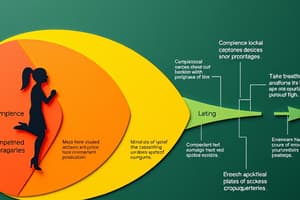Podcast
Questions and Answers
What is the primary purpose of retirement villages?
What is the primary purpose of retirement villages?
- To function as a nursing home for disabled individuals
- To provide full medical care to residents
- To offer a managed community for seniors over 55 (correct)
- To facilitate temporary housing for the elderly
Which statement accurately describes Aging in Place?
Which statement accurately describes Aging in Place?
- A form of skilled nursing care provided at home
- A method that requires seniors to relocate to a managed community
- A concept that emphasizes independence while modifying the environment to assist daily living (correct)
- A program designed exclusively for people with dementia
What percentage of Australians aged 65 and older access some form of support or care at home?
What percentage of Australians aged 65 and older access some form of support or care at home?
- 40%
- 50%
- 15%
- 25% (correct)
What does residential aged care primarily cater to?
What does residential aged care primarily cater to?
Which of the following is included in the Commonwealth Home Support Programme?
Which of the following is included in the Commonwealth Home Support Programme?
What does the competence and environmental press model emphasize regarding individual functioning?
What does the competence and environmental press model emphasize regarding individual functioning?
In what way can environmental press be characterized according to the content?
In what way can environmental press be characterized according to the content?
What are preventive adaptations according to the Preventive and Corrective Proactivity (PCP) model?
What are preventive adaptations according to the Preventive and Corrective Proactivity (PCP) model?
How does proactivity differ from docility in dealing with environmental press?
How does proactivity differ from docility in dealing with environmental press?
What role does ‘Zone of Maximum Comfort’ play in the competence and environmental press model?
What role does ‘Zone of Maximum Comfort’ play in the competence and environmental press model?
What is the percentage of residents in aged care facilities that are 85 years or older?
What is the percentage of residents in aged care facilities that are 85 years or older?
Which statement about the distribution of residential aged care facilities is accurate?
Which statement about the distribution of residential aged care facilities is accurate?
What proportion of aged care residents has high care needs?
What proportion of aged care residents has high care needs?
Which demographic characteristic is NOT commonly associated with residents of residential aged care?
Which demographic characteristic is NOT commonly associated with residents of residential aged care?
What stereotype about aging is known to influence communication with older adults?
What stereotype about aging is known to influence communication with older adults?
Which factor contributes to higher usage rates of Home and Community Care among non-English speakers?
Which factor contributes to higher usage rates of Home and Community Care among non-English speakers?
What percentage of older adults in North America reported experiencing ageism?
What percentage of older adults in North America reported experiencing ageism?
What is a common result of stereotype threat on older adults?
What is a common result of stereotype threat on older adults?
Why is ageism considered a complex prejudice?
Why is ageism considered a complex prejudice?
Which of the following is NOT a common health issue among residential aged care residents?
Which of the following is NOT a common health issue among residential aged care residents?
Study Notes
Competence and Environmental Press Model
- The Competence and Environmental Press Model understands that a person's ability to function is limited by their capacity (competence), which is socially, physically, and psychologically influenced.
- The environment has varying demands, called environmental press, and its level can be classified based on the demands placed on the individual.
- An individual adapts well to a specific range of living conditions, but not to every condition.
- Institutional care provides a homogenous level of environmental press, which might not be suitable for everyone's varying competency levels.
- The environment should be adjusted dynamically to meet appropriate press conditions.
- Environmental press can be both objective (measurable) and subjective (perceived).
Proactivity and Docility
- Individuals may react to environmental press in two ways: proactivity and docility.
- Proactivity is characterized by increasing personal competence and utilizing environmental resources for better outcomes.
- Docility is marked by declining personal competence and a greater reliance on environmental factors.
Preventive and Corrective Proactivity Model (PCP)
- This model explains how life stressors and mismatch between personal capabilities and environmental demands lead to poor life outcomes.
- Proactive adaptations are crucial for navigating these stressors and improving life outcomes.
- Preventive adaptations are actions taken to avoid stressors and build social resources.
- Corrective adaptations are reactive actions taken in response to existing stressors, which can be facilitated by internal and external support.
Retirement Villages
- Retirement villages are managed communities specifically designed for seniors over 55, offering social, lifestyle, and financial benefits.
- They come in various forms, from independent living units to assisted living options.
- The average entry age in Australia is 75, with 8% of those over 75 living in retirement villages.
Home Care and Aging in Place
- Home care enables individuals to live independently in their own homes and communities, with assistance as needed.
- Aging in Place focuses on maintaining a balance between environmental press and individual competence through selection and compensation.
- Home Modifications aim to adapt the environment to help people with everyday tasks, making life easier.
Adult Home Help and Care
- The Commonwealth Home Support Programme (CHSP) and Home Care Packages Programme (HCPP) provide social, recreational, and practical support to individuals.
- They include day centres for therapeutic activities, domestic assistance like transport and home help.
- Approximately 25% of Australians aged 65+ utilize some form of home support or care.
- About 50% of those who receive home help eventually transition to residential aged care.
Residential Aged Care (RAC)
- Residential aged care is for people who can no longer live at home due to illness, disability, or other needs.
- In 2018, there were 216,000 government-subsidized places in RAC in Australia.
- The average resident is over 85 years old and often has significant mental and physical problems.
- Common characteristics of RAC residents include age, gender, recent hospital admission, marital status, family proximity, cognitive impairments, and dependence on others for activities of daily living.
- Almost half the residents are in privately run facilities, with a significant number requiring high care needs.
CALD Older Australians
- 37% of Australians aged 65+ were born overseas, with a significant proportion born in Europe and Asia.
- Most report speaking English well or very well at home.
- Those who don't speak English are more likely to utilize home and community care services but less likely to reside in RAC.
Stereotypes and Ageing
- Stereotypes are pre-existing social knowledge structures or beliefs about groups of people that influence our interpretation of new information.
- Both young and older adults hold similar stereotypes about ageing.
- An age-based double standard exists when people judge older adults' memory failures more harshly than younger adults.
Stereotype Threat
- Stereotype threat is the fear of being judged based on negative stereotypes associated with a group you belong to.
- It can impact older adults' performance and well-being, influencing their perception of themselves and how they are treated.
Ageism
- Ageism is a form of prejudice that involves both positive and negative stereotypes about older adults.
- While often seen as less severe than other forms of discrimination, it is prevalent and experienced by many older adults.
- Common forms of ageism include patronizing, ignoring, and treating older adults as incompetent.
Self-Perceptions of Ageing
- Older adults' perceptions of their own age and ageing are influenced by various factors.
- The Labeling Theory suggests that when confronted with age-related stereotypes, older adults may integrate them into their self-perception.
- The Resilience Theory proposes that confrontation with negative stereotypes leads to a rejection of those views, promoting self-affirmation.
Perceptions of Others
- Age differences are found in the endorsement of social rules and norms.
- Older adults use less detailed information when forming first impressions of others, often exhibiting a negativity bias.
Social Judgment Processes
- Social knowledge plays a crucial role in navigating new situations, drawing upon past experiences stored in memory.
- Source judgments involve determining the source of information.
- Declines in cognitive processing resources may affect social judgment processes.
Social Judgments and Causal Attributions
- Causal attributions are explanations people create to understand behavior.
- Dispositional attributions attribute behavior to internal factors like personality traits.
- Situational attributions attribute behavior to external factors like circumstances.
- Correspondence bias occurs when people rely on dispositional information while overlooking situational information.
Studying That Suits You
Use AI to generate personalized quizzes and flashcards to suit your learning preferences.
Related Documents
Description
Explore the Competence and Environmental Press Model, which examines how a person's ability to function is influenced by both their competence and the demands of their environment. Learn about the balance between individual adaptation and the environment's varying press levels, as well as the concepts of proactivity and docility in response to these factors.



